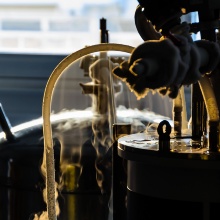The research topics the group is interested in
Magnetic anisotropy of molecular nanomagnets
Magnetic anisotropy is the key property that can lead to bistable magnetization in molecular compounds. This may one day allow them to be used in ultrahigh-density magnetic data storage devices. The relaxation of the magnetization is intricately linked with the precise details of the electronic structure of the molecule. We use a wide range of spectroscopic, magnetic and theoretical methods to investigate the electronic structure and its relation of the magnetization relaxation. Thus we aim to create blueprints for improved molecular nanomagnets.
M. Perfetti, M. Gysler, Y. Rechkemmer, P. Zhang, H. Taştan, F. Fischer, J. Netz, W. Frey, L. Zimmermann, T. Schleid, M. Hakl, M. Orlita, L. Ungur, L. Chibotaru, T. Brock-Nannestad, S. Piligkos, J. van Slageren, Determination of the electronic structure of a dinuclear dysprosium single molecule magnet without symmetry idealization, Chem. Sci., 10, 2101 - 2110 (2019).
P. Zhang, M. Perfetti, M. Kern, P.P. Hallmen, L. Ungur, S. Lenz, M.R. Ringenberg, W. Frey, H. Stoll, G. Rauhut, J. van Slageren, Exchange Coupling and Single Molecule Magnetism in Redox-active Tetraoxolene-bridged Dilanthanide Complexes, Chem. Sci., 9, 1221 – 1230 (2018).
P.P. Hallmen, C. Köppl, G. Rauhut, H. Stoll, J. van Slageren, Fast and reliable ab initio calculation of crystal field splittings in lanthanide complexes, J. Chem. Phys., 147, 164101 (2017).
Y. Rechkemmer, F.D. Breitgoff, M. van der Meer, M. Atanasov, M. Hakl, M. Orlita, P. Neugebauer, F. Neese, B. Sarkar, J. van Slageren, A Four-Coordinate Cobalt(II) Single Ion Magnet With Coercivity and a Very High Energy Barrier, Nat. Commun., 7, 10467 (2016).
Y. Rechkemmer, J.E. Fischer, R. Marx, M. Dörfel, P. Neugebauer, S. Horvath, M. Gysler, T. Brock-Nannestad, W. Frey, M.F. Reid, J. van Slageren, Comprehensive Spectroscopic Determination of the Crystal Field Splitting in an Erbium Single-Ion Magnet, J. Am. Chem. Soc., 137, 13114–13120 (2015).
Quantum coherence in molecular quantum bits
Molecular quantum bits are paramagnetic molecules that can be put in superposition states of their magnetic levels. The lifetime of such a superposition state is the coherence time, which is the time available for a quantum computation. These times can be rather long making molecular quantum bits very promising for application in quantum technologies such as quantum sensing. We study the origin and mechanisms of decoherence which will lead to the development of improved molecular quantum bits. In addition, we are developing molecular that feature several quantum bit centres for quantum gate implementation.
S. Lenz, B. Kern, M. Schneider, J. van Slageren, Measurement of quantum coherence in thin films of molecular quantum bits without post-processing, Chem. Commun., 55, 7163 – 7166 (2019).
O. Laguta, M. Tuček, J. van Slageren, P. Neugebauer, Multi-frequency rapid-scan HFEPR, J. Magn. Reson., 296, 138 – 142 (2018).
S. Lenz, K. Bader, H. Bamberger, J. van Slageren, Quantitative prediction of nuclear-spin-diffusion-limited coherence times of molecular quantum bits based on copper(II), Chem. Commun., 53, 4477 - 4480 (2017).
K. Bader, D. Dengler, S. Lenz, B. Endeward, S.D. Jiang, P. Neugebauer, J. van Slageren, Room Temperature Quantum Coherence in a Potential Molecular Qubit, Nat. Commun., 5, 5304 (2014).
Addressing spin centers with mobile charge carriers
In devices, neither molecular nanomagnets nor molecular quantum bits will be used as bulk materials, but rather as thin films or ordered arrays. Also, they will not be addressed and read out by means of magnetic fields or microwave radiation but rather by means of electrical currents. Therefore we are studying thin films of paramagnetic molecules, their hybrid materials with conducting polymers and their deposition on conducting substrates. We are interested on a fundamental level in the interactions between stationary spin centers and mobile charge carriers. This has led us on a foray into the realm of surfaces and interfaces, spintronics and 2D materials.
S. Bechler, M. Kern, H. S. Funk, G. Colston, I. A. Fischer, D. Weißhaupt, M. Myronov, J. van Slageren, J. Schulze, Formation of Mn5Ge3 by thermal annealing of evaporated Mn on doped Ge on Si(111), Semicond. Sci. Technol., 33, 095008 (2018).
F. Ciccullo, M. Glaser, M. Sättele, S. Lenz, P. Neugebauer, Y. Rechkemmer, J. van Slageren and M. B. Casu, Thin Film Properties and Stability of a Potential Molecular Quantum Bit Based on Copper(II), J. Mater. Chem. C, 6, 8027 – 8034 (2018).
J. Rozbořil, Y. Rechkemmer, D. Bloos, F. Münz, C.N. Wang, P. Neugebauer, J. Čechal, J. Novák, J. van Slageren*, Magneto-optical investigations of molecular nanomagnet monolayers, Dalton Trans., 45, 7555 – 7558 (2016).





